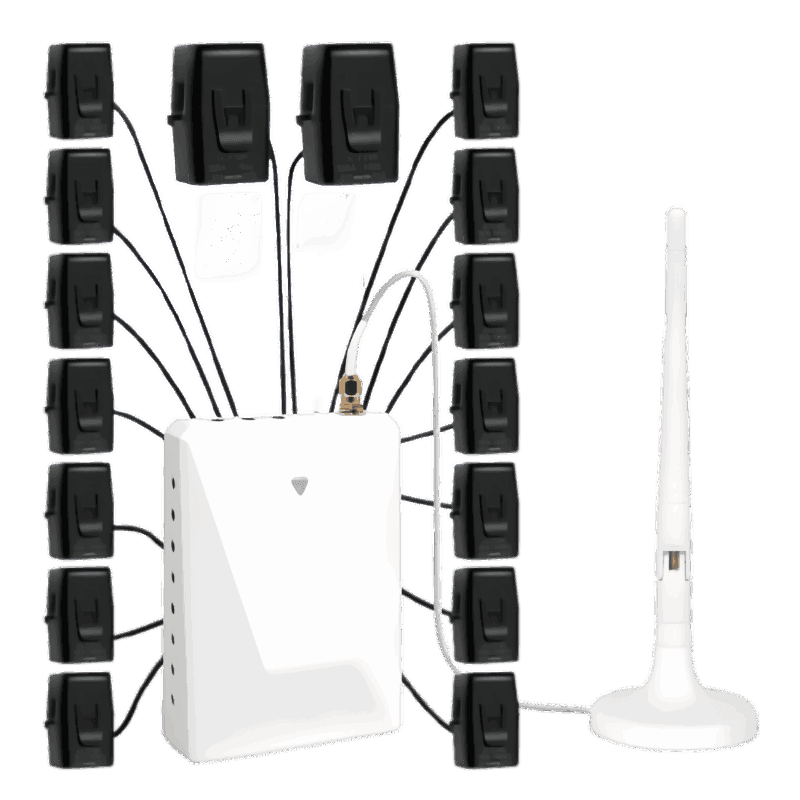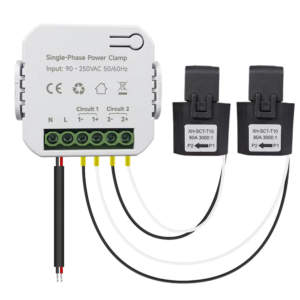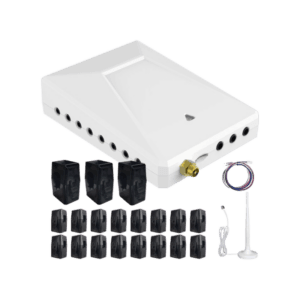Why Is My Electric Bill So High This Month?
Opening your utility email and seeing a total that’s 30 percent higher than last month is enough to ruin a morning coffee. Across the United States, electricity prices keep inching upward—according to the U.S. Energy Information Administration, the national residential rate has climbed more than 5 percent in the past year alone. But a rising national average isn’t the only reason your bill suddenly spikes.
A higher-than-usual bill usually means something in your house changed—usage, equipment, or the rate plan itself. Before you call the utility or assume the meter is wrong, you can take a few quick steps to narrow the possibilities.
Quick Self-Check Before You Call the Utility
When a bill jumps overnight, start with a data check before blaming the power company.
- Compare Usage, Not Just Dollars
Download last month’s and last year’s statements from your utility portal (Duke Energy, PG&E, Con Edison—every provider offers this). Look at total kWh, not only cost. If usage rose sharply, the cause is inside your home. - Verify the Meter
Walk out to your exterior meter and note the number. Compare it to the “current reading” on your bill. Snap a quick photo for your records. If the reading on the meter is lower than the bill shows, call the utility immediately. Most companies, including Con Edison, even provide step-by-step instructions on how to read your own meter. - Check Time-of-Use Rates
Many utilities now charge more during peak evening hours. In California, for example, on-peak electricity can cost twice the midnight rate. If your household runs the dryer or dishwasher right after dinner, those few evening loads can explain a surprising increase even if total kWh stayed steady.
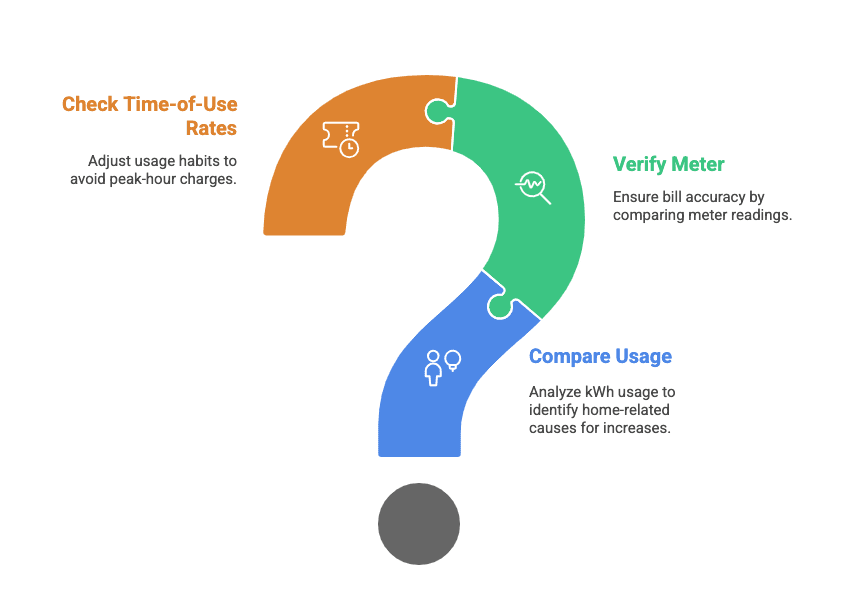
Taking these three actions first gives you solid evidence before you contact the power company. It also helps you spot patterns—like a new appliance or an overlooked habit—that could be running up the tab.
For homeowners who want deeper answers, a circuit-level view is the next step. A split-phase home energy monitor can reveal, in real time, which breaker or appliance is consuming the most power and when. In the next section we’ll look at the most common hidden culprits and how real families uncovered them.
Ten Real Causes of a High Electric Bill This Month
The next step is to look for specific, proven reasons. Below are ten causes drawn from real North-American homes, with typical costs and quick ways to check each one.
1. Seasonal Heating and Cooling Can Make Your Electric Bill High This Month
Heating and cooling account for 40–50 % of household electricity in many climates. A central air conditioner running 10 hours a day can add 500 kWh in a single month—around $80–$120 at average U.S. rates. In winter, electric baseboard heaters or a heat pump’s emergency mode can double normal consumption. Compare this month’s average outdoor temperature with last year’s to see if weather alone explains the jump.
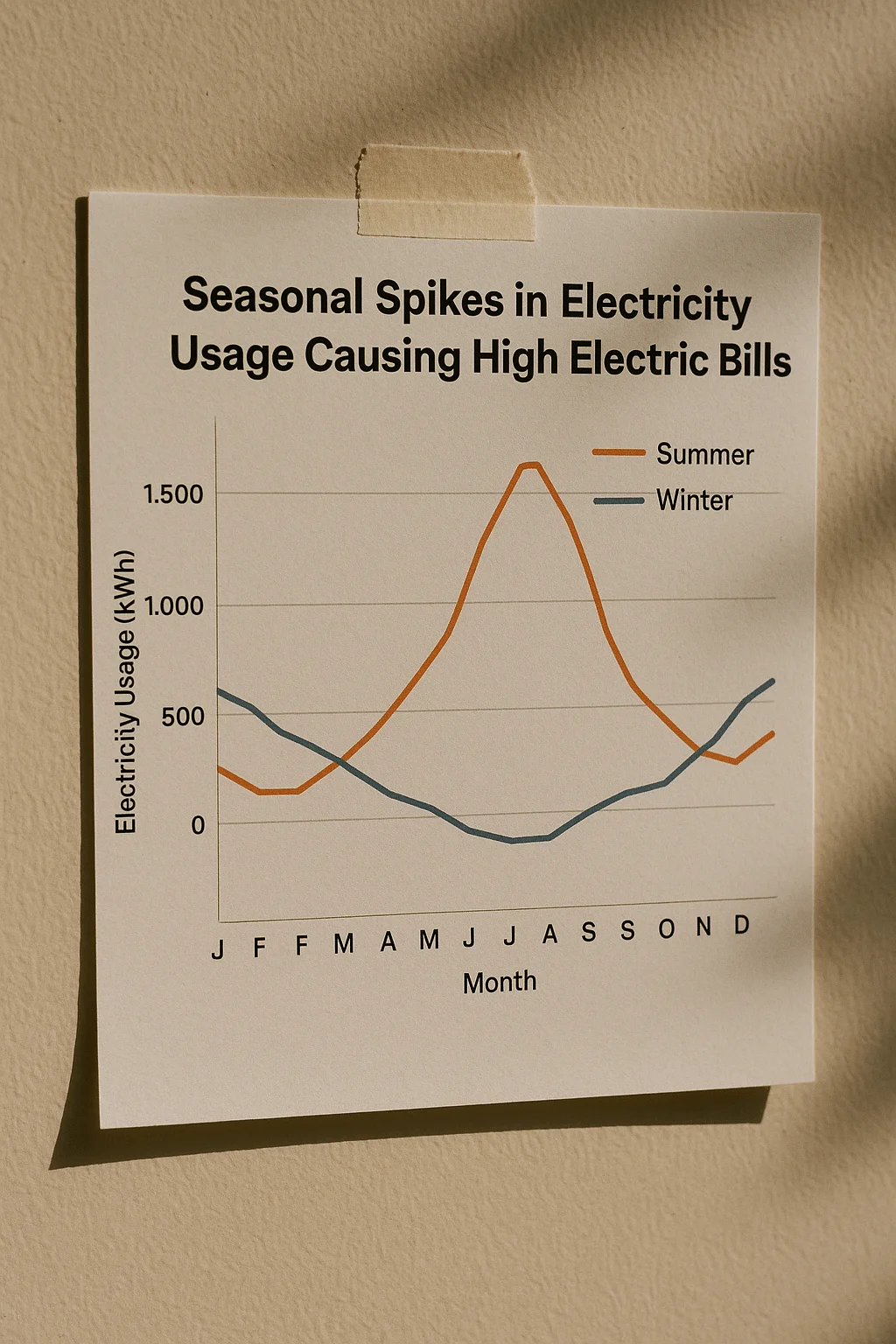
2. Hidden “Vampire Loads”
Devices that never truly turn off—garage fridges, old dehumidifiers, cable boxes—quietly consume power 24/7. The U.S. Department of Energy estimates these phantom loads account for 5–10 percent of household electricity. One homeowner discovered a forgotten chest freezer pulling 150 kWh a month—over $20 at Midwest rates.
3. Utility Rate Increases or Fuel Surcharges
Sometimes usage hasn’t changed at all; the price per kWh has. Many utilities quietly add “fuel adjustment” or “power cost recovery” fees mid-year. Check your bill’s line items and the utility’s “tariff update” page. A modest 3-cent rate hike on a 1,000 kWh bill adds $30 instantly.
4. Appliance Malfunctions
A failing water-heater thermostat or refrigerator compressor can run non-stop. A Colorado family documented a $90 monthly spike traced to a defective fridge defrost heater. Listen for equipment that never cycles off, or use a clamp-on energy monitor to identify a constantly high draw.
5. Lifestyle Changes
Working from home, hosting long-term guests, or adding a newborn’s laundry can quietly add 100–200 kWh. Even a small habit—running the dishwasher nightly instead of every other day—adds up. Track changes in occupancy or routines over the billing period.
6. Time-of-Use Peak Consumption
In areas with Time-of-Use (TOU) pricing—California, Arizona, parts of Ontario—electricity may cost twice as much during evening peaks. A 5 kW dryer running for one hour at $0.45/kWh instead of $0.18/kWh adds $1.35 per load. Shift heavy loads to off-peak hours to see immediate savings.
7. Solar Surprises
Many homeowners expect near-zero bills after installing panels and are shocked when charges climb. Causes include inverter failure, shading from new tree growth, or a tripped breaker that stops net-metering. Check the inverter display and your monitoring app to confirm actual output.
8. Poor Insulation or Air Leaks Making Your Electric Bill High This Month
Drafty windows and unsealed attic hatches let heated or cooled air escape. A simple smoke-pen test or an infrared camera borrowed from a local library can reveal leaks that add $20–$40 per month in extra HVAC runtime.
9. Electric Vehicle Charging Habits
Level-2 EV chargers draw 6–7 kW. Charging nightly during on-peak hours can add $40–$60 to a monthly bill. Schedule overnight charging to align with off-peak rates.
10. Old or Oversized Water Heaters
Electric water heaters typically consume 350–500 kWh per month. If the thermostat is set above 120 °F or sediment reduces efficiency, usage can double. Drain and flush the tank annually and check the thermostat setting.
How to Investigate Each Cause
- Check usage by circuit: A split-phase home energy monitor shows which breaker spikes when the A/C or heater cycles.
- Log patterns: Record daily kWh from your utility’s smart-meter portal to spot sudden jumps.
- Isolate loads: Turn off suspected appliances for a few hours and watch the monitor’s live graph.
Every one of these issues has shown up repeatedly in homeowner forums like r/HomeImprovement and r/Electricians. They’re the real reasons many families suddenly ask, “Why is my electric bill so high this month?”
Case Study: Two Homes, Two Outcomes
Sometimes the fastest way to learn is to see how other homeowners solved the exact problem you’re facing. These two North-American households both opened their statements and thought, “Why is my electric bill so high this month?”—but their paths to an answer looked very different.
Case Study A: Months of Guesswork Without a Monitor
Last February in suburban Pennsylvania, the Miller family received a bill that leapt from $120 to $180 in a single cycle. They double-checked the meter, turned off lights more aggressively, and even unplugged a few electronics, but nothing explained the extra 200 kWh.
- First Month: They blamed a cold snap.
- Second Month: The weather warmed, yet the bill stayed high.
- Third Month: They hired an electrician for a full diagnostic.
The culprit turned out to be a hot-water recirculation pump whose thermostat had failed, running twenty-four hours a day. By the time it was replaced, the Millers had paid nearly $200 in unnecessary electricity plus the service call. Looking back, they wished they’d had circuit-level data on day one.
Case Study B: Quick Detection With a Split-Phase Monitor
Across the country in Oregon, the Ramirez family added an electric vehicle and worried about rising usage. Before the first full billing cycle, they installed a WattPanel-2X Split-Phase Home Energy Monitor so they could see real-time consumption for each breaker.
Two weeks later, the monitor’s dashboard flagged an unusual spike on a basement freezer circuit—four times its normal current draw. The Ramirezes discovered that the freezer door gasket had cracked, causing the compressor to run almost nonstop.
- Immediate Action: They replaced the gasket for $25.
- Result: Monthly usage dropped by 150 kWh, saving roughly $30 per month—enough to pay for the monitor within a few billing cycles.
Key Takeaways
Both families asked the same question—why is my electric bill so high this month—but only the second had the tools to answer it in days instead of months. Circuit-level monitoring didn’t just spot the problem; it provided hard data the utility could confirm, avoiding a drawn-out investigation and unnecessary charges.
Why Circuit-Level Monitoring Solves the Mystery
After reading those case studies, it’s clear that the question “why is my electric bill so high this month” often can’t be answered by looking at a utility statement alone. Your monthly bill is like the total on a restaurant check: it shows the grand sum but never tells you which dish cost the most. To uncover the real power hogs, you need visibility circuit by circuit.
The Limits of a Standard Utility Meter
Most North-American homes receive split-phase 120/240-volt service. Two “hot” legs deliver power, and the utility meter simply measures the combined flow. Even with a smart meter that reports hourly usage, you still can’t tell whether last night’s spike came from the upstairs heat pump, a failing freezer compressor, or the kids’ gaming PC running all night. That’s why many homeowners remain stuck wondering why is my electric bill so high this month even after careful self-checks.
How a Split-Phase Home Energy Monitor Works
A circuit-level monitor changes that picture. The WattPanel-2X Split-Phase Energy Monitor installs inside the breaker panel with simple clamp-on current transformers (CTs). Each CT loops around a circuit wire—no rewiring required—and reports live data to a secure Wi-Fi hub.
- Real-Time Graphs: See second-by-second current draw from each breaker.
- Per-Circuit Detail: Track up to sixteen circuits with ±2 % accuracy, enough to catch a failing appliance before it drives up your bill.
- Custom Alerts: Set thresholds so you receive a push notification when a circuit suddenly pulls more than expected.
- Smart-Home Integration: Compatible with Home Assistant, Google Home, and other major platforms.
A licensed electrician can usually complete installation in about an hour: shut off the main breaker, clip the CT sensors onto the selected circuit wires, and connect the monitor to Wi-Fi. Because it’s non-invasive, the process does not void most panel warranties.
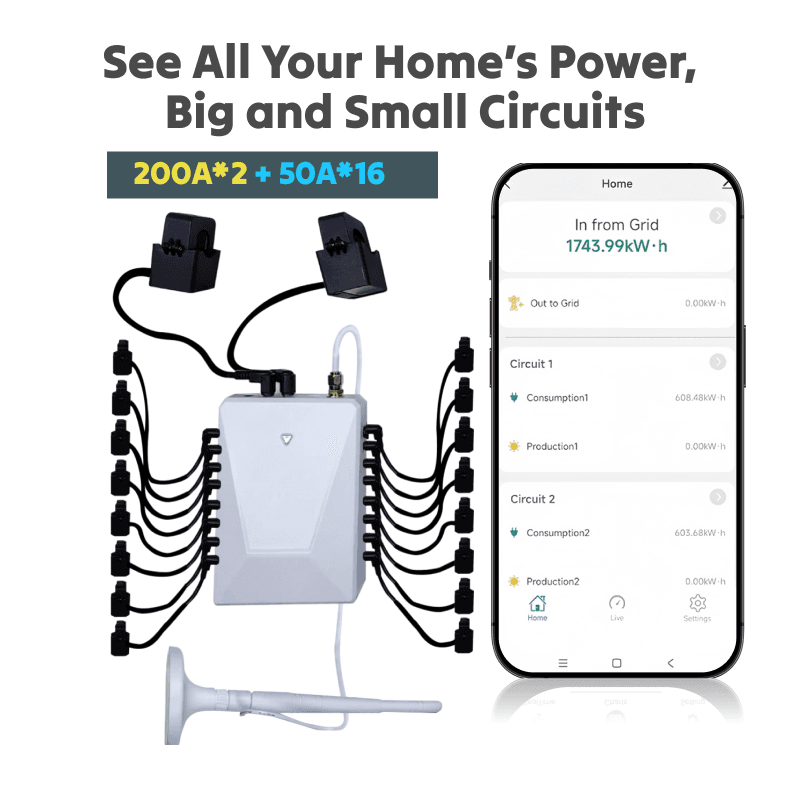
Turning Data Into Savings
Once the monitor is running, you no longer guess which circuit caused the spike. If the upstairs HVAC draws 3 kW at midnight or the garage fridge runs continuously, you’ll see it immediately. Homeowners who start with the question “why is my electric bill so high this month” often recover the cost of the monitor within a few billing cycles simply by fixing the first abnormal load they discover.ng.
Cutting Your Bill Once You Find the Culprit
By now you’ve checked the obvious things, installed a monitor, and answered the big question—why is my electric bill so high this month. The next challenge is turning those insights into lower bills month after month. Here are proven, data-driven steps that North-American homeowners use once the source of excess power is clear.
1. Fix or Replace Problem Appliances
If your circuit-level data shows a failing refrigerator compressor or a water-heater thermostat stuck in the “on” position, repair or replace it right away. A single malfunctioning appliance can waste 150–300 kWh every month.
Tip: many utilities offer rebates for Energy Star replacements—check your local program before buying.
2. Shift Heavy Loads Off-Peak
Even if your total usage stays steady, Time-of-Use pricing can double costs during evening hours. Once your monitor reveals which devices draw the most power, program smart plugs or timers to run those loads overnight. A family in Ontario saved $35 a month by moving electric-vehicle charging to the midnight window.
3. Tighten the Envelope
Your monitor might show that HVAC runs far longer than expected. That’s often a sign of air leaks or poor insulation.
- Seal attic hatches, weather-strip doors, and caulk window gaps.
- Upgrade to modern double-pane windows if drafts are obvious.
These steps reduce runtime and can cut winter bills by 10–20 %.
4. Pair Monitoring With Smart Thermostats
Use your real-time data to guide thermostat schedules. Lowering the setpoint just 2 °F overnight trims about 5 % from heating costs. A Wi-Fi thermostat linked to your home energy monitor makes these adjustments automatic.
5. Join Utility Rebate or Demand-Response Programs
Many utilities—PG&E’s SmartRate, Con Edison’s Smart Usage, and others—pay customers who reduce use during peak demand. After your monitor identifies flexible loads, you can confidently enroll and earn credits without guesswork.
Bottom line: once you’ve discovered why your electric bill is so high this month, the real savings come from acting on that knowledge. Whether it’s a quick gasket repair, smarter scheduling, or an insulation upgrade, the data from your split-phase monitor turns a mystery into a manageable to-do list and keeps future bills predictable.
FAQ: Quick Answers to Common Questions
Why is my electric bill so high this month in winter?
Electric resistance heat, space heaters, and heat-pump defrost cycles draw massive power when temperatures drop. Even homes with gas furnaces see higher bills because blower motors and humidifiers run longer. Compare your current kWh to last year’s winter statement—weather alone can explain a 20 % bump.
Why is my apartment electric bill so high this month?
Older apartment buildings often have poor insulation and drafty windows. Window-unit heaters or air conditioners cycle constantly to keep up. If your unit shares walls with others but has its own meter, you may be paying for more conditioned air than you realize.
Why is my electric bill so high this month with solar panels?
Solar owners sometimes assume the grid draw will be near zero. But inverter failures, shading from new tree growth, or a tripped breaker can reduce generation dramatically. Always check your inverter’s daily output and your utility’s net-metering report.
Can a home energy monitor immediately lower my electric bill?
The monitor itself doesn’t cut usage, but by showing which circuits spike—often within hours—it lets you fix issues before the next statement. Many families recoup the cost in one or two billing cycles.
Is a split-phase monitor safe to install?
Yes, when installed by a licensed electrician. The WattPanel-2X Split-Phase Energy Monitor uses clamp-on current transformers so there’s no rewiring, and the main breaker is off during installation.
Final Thoughts and Next Steps
A shocking bill doesn’t mean you’re powerless. Start with a careful bill comparison, check the meter, and audit your habits. Then bring technology to the fight: a split-phase home energy monitor delivers the circuit-level insight your utility meter never could.
Stop guessing. Track every circuit before your next statement with the WattPanel-2X Split-Phase Energy Monitor.

